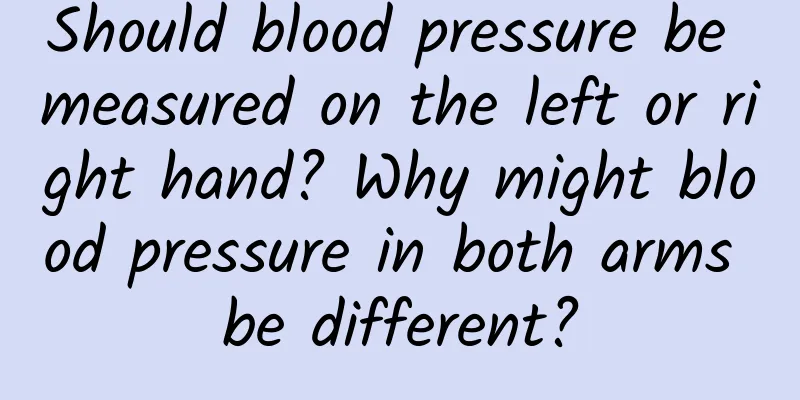Should blood pressure be measured on the left or right hand? Why might blood pressure in both arms be different?

|
Measuring blood pressure is a very important part of daily health management. Should you use your left or right hand to measure blood pressure? How to measure it correctly? Director Xie Le of the Department of Neurology (Department of Encephalopathy) of Hunan Hospital of Integrated Traditional Chinese and Western Medicine (Affiliated Hospital of Hunan Institute of Traditional Chinese Medicine) will answer your questions. Theory 1: Right arm The right brachial artery of the human body comes from the branch of the brachiocephalic trunk, and the left brachial artery comes from the left subclavian artery. The brachiocephalic trunk and the left subclavian artery both come from the aorta, and the brachiocephalic trunk is a larger branch of the aorta, while the left subclavian artery is a smaller branch. Therefore, the blood pressure of the right arm is usually about 5~10mmHg higher than that of the left hand. Therefore, it is generally recommended to measure the blood pressure of the right arm. Explanation 2: Left arm From an anatomical point of view, the distance from the heart to the right brachial artery is slightly farther than that to the left brachial artery. The left brachial artery is closer to the center, so theoretically the pressure in the left brachial artery is higher than that in the right side. 1. Which hand is more suitable for measuring blood pressure? According to international guidelines and medical research, there is no absolute requirement to use the left or right hand when measuring blood pressure, but it is necessary to compare the blood pressure of both arms. The following are basic recommendations for measuring blood pressure: When measuring for the first time, it is recommended to measure blood pressure in both hands - for the first check, measure blood pressure once with your left arm and once with your right arm, and then compare the difference between the two. If the difference in blood pressure between the two arms is small (generally less than 10 mmHg), you can choose to use either arm, usually based on convenience. If the difference in blood pressure between the two arms is large (more than 15 mmHg), it may indicate certain underlying health problems, such as narrowing of the arteries, and further medical examination is needed. Subsequent blood pressure monitoring should be based on the side with higher blood pressure. If the blood pressure of one arm is long-term high, it is recommended to use this arm for measurement in the future to monitor possible risks of hypertension. 2. Why might the blood pressure in the two arms be different? The reasons for differences in blood pressure between the two arms are usually related to vascular anatomy and hemodynamics. Here are some possible reasons: Normal physiological differences: It is normal for the blood pressure difference between the two arms to be less than 10 mmHg, which may be caused by slight differences in arm muscles, blood vessel distribution, etc. Arterial problems: If the difference is larger (15 mmHg), it may indicate atherosclerosis, subclavian artery stenosis, or peripheral arterial disease. Measurement error: cuff tightness, measurement posture, and even psychological state can affect blood pressure measurement results. 3. How to measure blood pressure correctly? Regardless of which hand you choose to measure your blood pressure, proper measurement technique is key to ensuring accurate results: 1. Keep quiet and avoid exercise, smoking, coffee or tea for at least 30 minutes before measurement. Empty your bladder and avoid physical discomfort. 2. Sit in the right position: with your back supported and your feet flat on the floor. Your arms should be at heart level and relaxed on the table. 3. Choose the right cuff: The cuff size should fit your arm. Too small or too large will affect the results. 4. Repeat the measurement: Each measurement should be performed with an interval of 1 to 2 minutes, and the average value of multiple measurements should be taken. 4. Special reminder: 1. Home monitoring: If you measure your blood pressure at home for a long time, it is recommended to record the measurement time, value and arm for easy sharing with your doctor. 2. Health warning: If you find that your blood pressure is unstable or there is a significant difference between the two arms, you should consult a doctor immediately. Experts advise Professor Wu Dahua, the leader of the encephalopathy discipline, reminds: When measuring blood pressure, there is no fixed choice between the left hand and the right hand, but both sides should be compared for the first measurement, and the side with higher blood pressure should be used as the standard afterwards. At the same time, standardized measurement methods and good living habits are equally important. I hope that through this article, you can manage your blood pressure more scientifically and protect your health! Hunan Medical Chat Special Author: Xie Le Huang Lin, Department of Neurology (Department of Encephalopathy), Hunan Provincial Hospital of Integrated Traditional Chinese and Western Medicine (Affiliated Hospital of Hunan Institute of Traditional Chinese Medicine) Follow @湖南医聊 to get more health science information! (Edited by Wx) |
>>: Outrageous! Are crabs causing havoc in blue carbon storage?
Recommend
This app can make the iPhone X's bangs disappear
The much-anticipated iPhone X has begun shipping....
Google's disappointing plan to return to China!
[[154043]] There have been many reports that Goog...
Microsoft copied more OS X gestures in Windows 10
According to a report by The Verge, a Windows 10 ...
Zhihu operation and promotion: the optimal solution for Zhihu recommendation algorithm!
I want to tell everyone: Don’t just focus on Baid...
How do cash loan products promote and acquire customers?
What is a cash loan? At present, the definition o...
Is chapped lips caused by dryness?
In the cold winter, many people's lips are re...
Tea polyphenols may cause liver toxicity. The EU has introduced new regulations to limit intake. Can we still drink more green tea?
First of all, green tea is a good thing. Green te...
Analysis of the most effective Taobao promotion methods for Taobao operations
Many sellers currently have a problem, that is, t...
Answers to 31 difficult questions about Xiaohongshu’s monetization and operations!
As more and more brands and organizations flock t...
Android 7.0 ranks first in market share: Have you upgraded?
A few days ago, Google released the latest statis...
What are some ways to increase followers on Tik Tok? How to increase the number of Douyin followers to 1,000?
This article mainly introduces the methods of inc...
From CCTV to Google: Let’s talk about the bidding advertising system mechanism!
Regarding bidding ads, many people have two extre...
Is Papi Jiang really hard to replicate?
The short video industry started to boom in 2016....
A guide to cross-brand joint marketing!
When a cultural symbol is unable to interpret a l...
What are the advantages and disadvantages of Wancibaping promotion?
Presumably, many friends who are engaged in onlin...









